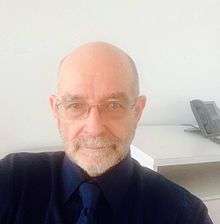Jeffrey Escoffier
| Jeffrey Escoffier | |
|---|---|
 | |
| Born |
October 9, 1942 Baltimore, Maryland |
| Nationality | American |
Jeffrey Escoffier (born October 9, 1942) is an American media strategist, writer, editor, historian and activist. He was the director of health media and marketing for the New York City Department of Health and Mental Hygiene (one of the world’s most prestigious public health agencies) from 1999 to 2015.[1]
Escoffier graduated from the “Great Books” program at St. John’s College Annapolis in 1964.[2] He received a master's degree from the School for International and Public Affairs at Columbia University in 1966, and did graduate work in economics (1966-1968) at Columbia University, where Nobel Prize winners Gary Becker and William Vickrey were among his professors. He went on to do graduate work in economic history at the University of Pennsylvania from 1969 to 1977.
Career
Escoffier has long been an active participant in the LGBT community in Philadelphia (1970-1977), San Francisco (1977-2002) and New York City (1992-present).[3] He was president of the Gay Activists Alliance in Philadelphia from 1971-1972.[4] In 1972 he co-founded and served on the editorial board of The Gay Alternative (1972-1976), a gay and lesbian cultural magazine.[5] He moved to San Francisco in 1977 where he co-founded the San Francisco Lesbian and Gay History Project that included Allan Berube, Amber Hollibaugh, Estelle Freedman, and Gayle Rubin, among others.[6]
In 1988, Escoffier co-founded OUT/LOOK: A National Lesbian and Gay Quarterly, one of the first joint lesbian and gay cultural ventures after the long political and cultural split between the lesbian and gay male movements that emerged in the late 1970s. Academy-award winning filmmaker Debra Chasnoff, artist E.G. Crichton and graphic designer Peter Babcock were among the founding group. Starting in 1990, OUT/LOOK sponsored, under Escoffier’s leadership, a series of conferences called OutWrite that brought together more than 1,200 LGBT writers from across the U.S.[7] Billed as the "largest gathering of lesbian and gay writers in history" and the conferences brought together well-known writers such Judy Grahn, Allen Ginsberg, Cherrie Moraga, Gore Vidal, Edward Albee and Essex Hemphill, as well as writers at the beginning of their careers. In the wake of the OutWrite conferences he worked as a literary agent and represented lesbian and gay authors from the Bay Area. In that capacity he represented Dorothy Allison’s Bastard out of Carolina.[8]
In 1978 he joined the editorial board of Socialist Review, a democratic socialistic journal, and served as Executive Editor from 1980 to 1988.[9]
In 1992, Escoffier moved back to New York City where he had grown up. He served on the board of the Center for Lesbian and Gay Studies (CLAGS) at the City University of New York from 1992-1995 and then from 2010-2013. He was the Director of the CLAGS Project on Families, Values and Public School Curriculum.[10]
In 1995, he joined the NYC Department of Health and Mental Hygiene as the Deputy Director of the Office of Gay and Lesbian Health. In 2000 he became the Director of Health Media and Marketing and was in that position until he retired in August 2015. In that position he supervised the production of the Department’s media and public education campaigns on such topics as smoking cessation, HIV prevention and testing, anti-obesity, Ebola, influenza and immunization campaigns.[11] He also pioneered the use of social media in public education campaigns. During his tenure the Health Department, he became known for producing emotionally wrenching "hard-hitting" campaigns that were criticized for relying on generating fear for their effectiveness.[12] Health departments throughout the United States, as well as in more than 24 countries, adopted many of these campaigns.
Works
- John Maynard Keynes (New York: Chelsea House, 1995)
- American Homo: Community and Perversity (Berkeley: University of California Press, 1998)
- Mark Morris' L'Allegro, il Penseroso ed il Moderato (New York: Marlowe & Co., 2001)
- Sexual Revolution (New York: Thunder's Mouth, 2003)
- Bigger Than Life: The History of Gay Porn Cinema from Beefcake to Hardcore (Philadelphia: Running Press, 2009)
References
- ↑ Jeffrey Escoffier LinkedIn profile
- ↑ Jeffrey Escoffier, “Pessimism of the Mind: Universities and the Decline of Public Discourse,” American Homo: Community and Perversity (Berkeley: University of California Press, 1998) p. 259, fn. 18.
- ↑ “Introduction,” American Homo, pp. 10-14
- ↑ Marc Stein, City of Sisterly and Brotherly Loves: Lesbian and Gay Philadelphia, 1945-1972, (Philadelphia: Temple University Press, xxxx), p. 360
- ↑ Thom Nichols, Gay and Lesbian Philadelphia (Mt. Pleasant, SC: Arcadia Publishing, 2002) p. xx; http://dla.library.upenn.edu/cocoon/dla/pacscl/ead.pdf?id=PACSCL_HSP_JJWSC0009
- ↑ GLBT Historical Society
- ↑ Zonana, Victor (7 March 1990). "Gay Literati Celebrate New Era of Acceptance : Publishing: The number of books by and about gays is increasing, as is the number of specialty book stores.". Los Angeles Times. San Francisco. Retrieved 21 February 2016.
- ↑ Susan Salter, “Dorothy Allison: A Family Redeemed,” Publisher’s Weekly, March 2, 1998.
- ↑ Socialist Review Collective, Unfinished Business: 20 Years of Socialist Review (New York: Verso, 1991)
- ↑ Duberman, Martin (Fall 1993). "Executive Director's Report". www.clags.org. City University of New York. Retrieved 21 February 2016.
- ↑ Tom Farley, Saving Gotham: A Billionaire Mayor, Activist Doctors, and the Fight For Eight Million Lives, (New York: W.W. Norton & Co., 2015) pp. 48, 56, 57, 65-66, 89-90, 194-195.
- ↑ Amy L. Fairchild, Amy L., Ron Bayer and James Colgrove, “Risky Business: New York City’s Experience with Fear-Based Public Health Campaigns,” Health Affairs 34, No. 5 (2015), p. 845